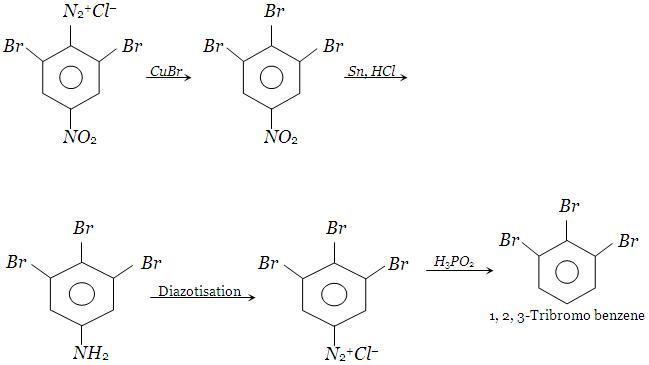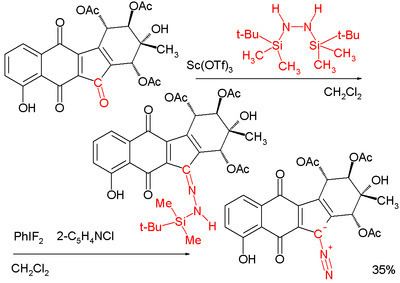 | ||
7 1 basic strength of amines
Diazonium compounds or diazonium salts are a group of organic compounds sharing a common functional group R−N+
2X−
where R can be any organic group, such as an alkyl or an aryl, and X is an inorganic or organic anion, such as a halogen. Diazonium salts, especially those where R is an aryl group, are important intermediates in the organic synthesis of azo dyes.
Contents
- 7 1 basic strength of amines
- Preparation
- Diazo coupling reactions
- Displacement of the N2 group
- Sandmeyer reaction
- Gatterman reaction
- Replacement by iodide
- Replacement by fluoride
- Replacement by hydrogen
- Replacement by a hydroxyl group
- Replacement by a nitro group
- Replacement by a cyano group
- Replacement by a thiol group
- Replacement by an aryl group
- Replacement by a carboxyl group
- Meerwein reaction
- Metal complexes
- Other methods for dediazotization
- Grafting reactions
- Reduction to a hydrazine group
- Applications
- Other uses
- Safety
- References

Preparation

The process of forming diazonium compounds is called "diazotation", "diazoniation", or "diazotization". The reaction was first reported by Peter Griess in 1858, who subsequently discovered several reactions of this new class of compounds. The most important method for the preparation of diazonium salts is treatment of aromatic amines such as aniline with nitrous acid. Usually the nitrous acid is generated in situ (in the same flask) from sodium nitrite and mineral acid. In aqueous solution diazonium salts are unstable at temperatures above 5 °C; the −N+≡N group tends to be lost as N2 (nitrogen gas). One can isolate diazonium compounds as tetrafluoroborate salts, which are stable at room temperature. Often, diazonium compounds are not isolated and once prepared, used immediately in further reactions. This approach is illustrated in the preparation of an arylsulfonyl compound:

It is often preferred that the diazonium salt remain in solutions, but they do tend to supersaturate. Operators have been killed and injured by an unexpected crystallization of the salt followed by its detonation.
Diazo coupling reactions

The most widely practiced reaction of diazonium salts is azo coupling. In this process, the diazonium compound is attacked by, i.e., coupled to, electron-rich substrates. When the coupling partners are arenes such as anilines and phenols, the process is an example of electrophilic aromatic substitution:
ArN+2 + Ar′H → ArN2Ar′ + H+

Another commercially important class of coupling partners are acetoacetic amides, as illustrated by the preparation of Pigment Yellow 12, a diarylide pigment.

The resulting azo compounds are often useful dyes and in fact are called azo dyes. The deep colors of the dyes reflects their extended conjugation. For example, the dye called aniline yellow is produced by mixing aniline and cold solution of diazonium salt and then shaking it vigorously. Aniline yellow is obtained as an yellow solid. Similarly, a cold basic solution of Naphthalen-2-ol (Β-naphthol) give the intensely orange-red precipitate. Methyl orange is an example of an azo dye that is used in the laboratory as a pH indicator.
Displacement of the N2 group
Arenediazonium cations undergo several reactions in which the N2 group is replaced by another group or ion. Some of the major ones are the following.
Sandmeyer reaction
Benzenediazonium chloride heated with cuprous chloride or cuprous bromide respectively dissolved in HCl or HBr yield chlorobenzene or bromobenzene, respectively.
C6H
5N+
2 + CuCl → C6H5Cl + N2 + Cu+
Gatterman reaction
In the Gatterman reaction, benzenediazonium chloride is warmed with copper powder and HCl or HBr to produce chlorobenzene and bromobenzene respectively. It is named after the German chemist Ludwig Gattermann.
C6H
5N+
2 + CuX → C6H5X + N2 + Cu+
Replacement by iodide
Iodine is not easily introduced into the benzene ring directly. However it can be introduced by treating aryldiazonium cations with potassium iodide:
C6H
5N+
2 + KI → C6H5I + K+ + N2
Replacement by fluoride
Fluorobenzene is produced by thermal decomposition of benzenediazonium fluoroborate. The reaction is called the Balz-Schiemann reaction.
[C6H
5N+
2]BF−
4 → C6H5F + BF3 + N2
Replacement by hydrogen
Arenediazonium cations are reduced by hypophosphorous acid or sodium stannite gives benzene:
[C6H
5N+
2]Cl− + H3PO2 + H2O → C6H6 + N2 + H3PO3 + HCl
Replacement by a hydroxyl group
Phenols are produced by heating aqueous solutions of aryldiazonium salts to 100 °C.
C6H
5N+
2 + H2O → C6H5OH + N2 + H+
This reaction goes by the German name Phenolverkochung ("cooking down to yield phenols"). The phenol formed may react with the diazonium salt and hence the reaction is carried in the presence of an acid which helps in suppressing this further reaction.
Replacement by a nitro group
Nitrobenzene can be obtained by treating benzenediazonium fluoroborate with sodium nitrite in presence of copper. Alternatively, the diazotisation of the aniline can be conducted in presence of cuprous oxide, which generates cuprous nitrite in situ:
C6H
5N+
2 + CuNO2 → C6H5NO2 + N2 + Cu+
Replacement by a cyano group
The cyano group usually cannot be introduced by nucleophilic substitution of haloarenes, but such compounds can be easily prepared from diazonium salts. Illustrative is the preparation of benzonitrile using the reagent cuprous cyanide:
C6H
5N+
2 + CuCN → C6H5CN + Cu+ + N2
This reaction is a special type of Sandmeyer reaction.
Replacement by a thiol group
Diazonium salts can be converted to thiols in a two-step procedure. Treatment of benzenediazonium chloride with potassium ethylxanthate followed by hydrolysis of the intermediate xanthate ester gives thiophenol:
C6H
5N+
2 + C
2H
5OCS−
2 → C6H5SC(S)OC2H5C6H5SC(S)OC2H5 + H2O → C6H5SH + HOC(S)OC2H5
Replacement by an aryl group
The aryl group can be coupled to another using aryldiazonium salts. For example, treatment of benzenediazonium chloride with benzene (an aromatic compound) in the presence of sodium hydroxide gives diphenyl:
[C6H
5N+
2]Cl− + C6H6 → C6H5−C6H5 + N2 + HCl
This reaction is known as the Gomberg–Bachmann reaction. A similar conversion is also achieved by treating benzenediazonium chloride with ethanol and copper powder.
Replacement by a carboxyl group
Diazonium fluoroborates react with an aliphatic carboxylic acid yield the corresponding benzoic acid. This reaction provides a method to prepare aromatic carboxylic acids from aliphatic carboxylic acids:
[C6H
5N+
2]BF−
4 + RCO2H → C6H5CO2H + BF3 + N2 + RF
Meerwein reaction
Benzenediazonium chloride reacts with compounds containing activated double bonds to produces phenylated products. The reaction is called the Meerwein arylation:
[C6H
5N+
2]Cl− + ArCH=CHCO2H → ArC=C−C6H5 + N2 + CO2 + HCl
Metal complexes
In their reactions with metal complexes, diazonium cations behave similarly to NO+. For example, low-valent metal complexes add with diazonium salts. Illustrative complexes are [Fe(CO)2(PPh3)2(N2Ph)]+ and the chiral-at-metal complex Fe(CO)(NO)(PPh3)(N2Ph).
Other methods for dediazotization
Grafting reactions
In a potential application in nanotechnology, the diazonium salts 4-chlorobenzenediazonium tetrafluoroborate very efficiently functionalizes single wall nanotubes. In order to exfoliate the nanotubes, they are mixed with an ionic liquid in a mortar and pestle. The diazonium salt is added together with potassium carbonate, and after grinding the mixture at room temperature the surface of the nanotubes are covered with chlorophenyl groups with an efficiency of 1 in 44 carbon atoms. These added subsituents prevent the tubes from forming intimate bundles due to large cohesive forces between them, which is a recurring problem in nanotube technology.
It is also possible to functionalize silicon wafers with diazonium salts forming an aryl monolayer. In one study, the silicon surface is washed with ammonium hydrogen fluoride leaving it covered with silicon–hydrogen bonds (hydride passivation). The reaction of the surface with a solution of diazonium salt in acetonitrile for 2 hours in the dark is a spontaneous process through a free radical mechanism:
So far grafting of diazonium salts on metals has been accomplished on iron, cobalt, nickel, platinum, palladium, zinc, copper and gold surfaces. Also grafting to diamond surfaces has been reported. One interesting question raised is the actual positioning on the aryl group on the surface. An in silico study demonstrates that in the period 4 elements from titanium to copper the binding energy decreases from left to right because the number of d-electrons increases. The metals to the left of iron are positioned tilted towards or flat on the surface favoring metal to carbon pi bond formation and those on the right of iron are positioned in an upright position, favoring metal to carbon sigma bond formation. This also explains why diazonium salt grafting thus far has been possible with those metals to right of iron in the periodic table.
Reduction to a hydrazine group
Diazonium salts can be reduced with stannous chloride (SnCl2) to the corresponding hydrazine derivatives. This reaction is particularly useful in the Fischer indole synthesis of triptan compounds and indometacin. The use of sodium dithionite is an improvement over stannous chloride since it is a cheaper reducing agent with fewer environmental problems.
Applications
The first use of diazonium salts was to produce water-fast dyed fabrics by immersing the fabric in an aqueous solution of the diazonium compound, followed by immersion in a solution of the coupler (the electron-rich ring that undergoes electrophilic substitution). The major applications of diazonium compounds remains in the dye and pigment industry.
Other uses
Diazonium compounds are standard reagents used in synthesis of organic compounds, especially aryl derivatives.
Diazonium salts are light sensitive and break down under near UV or violet light. This property has led to their use in document reproduction. In this process, paper or film is coated with a diazonium salt. After contact exposure under light, the residual diazo is converted to a stable azo dye with an aqueous solution of coupler. A more common process uses a paper coated with diazo, coupler and an acid to inhibit coupling; after exposure the image is developed by a vapor mixture of ammonia and water which forces coupling.
Safety
Solid diazonium halides are often dangerously explosive, and fatalities and injuries have been reported.
The nature of the anions affects stability of the salt. Aryl diazonium perchlorates, such as nitrobenzenediazonium perchlorate, have been used to initiate explosives. The tetrafluoroborate salts can be stored almost indefinitely at room temperature and decompose gently when heated.
